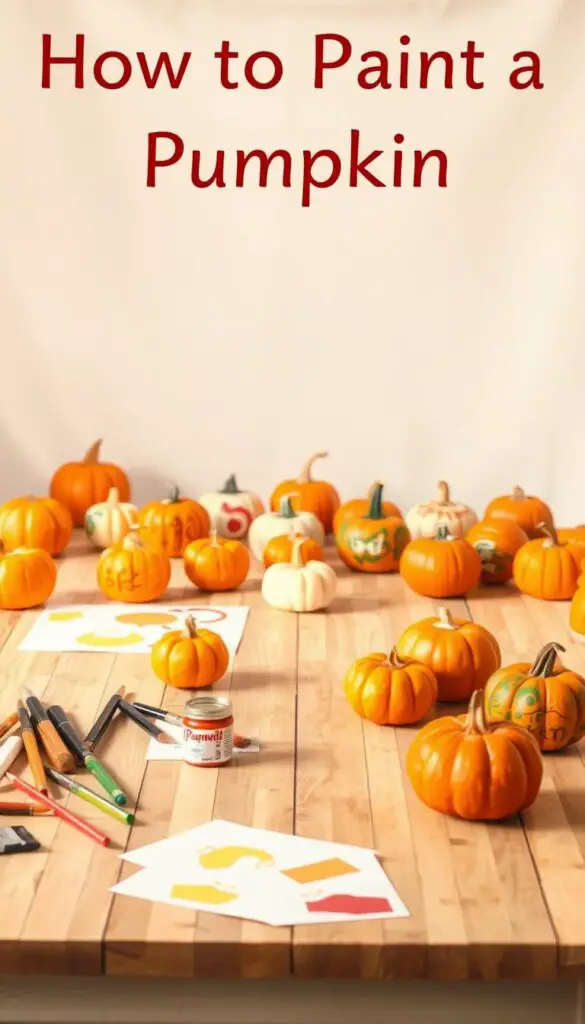Did you know that over 700,000 people have searched for tips on painting pumpkins? This fall favorite isn’t just for carving—painting pumpkins is a creative way to celebrate the season. Whether you’re a beginner or an experienced artist, this guide will help you create stunning designs that last beyond Halloween.
Using acrylic paint is a game-changer for this project. It’s versatile, dries quickly, and works beautifully on both real and craft pumpkins. Real pumpkins bring a natural charm, while craft pumpkins offer durability for year-round decor. With the right techniques, you can achieve professional-looking results.
This tutorial covers everything from materials to troubleshooting. You’ll learn easy-to-follow steps, tips for avoiding common mistakes, and ways to make your design pop. Whether you’re aiming for festive Halloween vibes or elegant autumn decor, this guide has you covered.
Key Takeaways
- Painting pumpkins is a fun and creative fall activity.
- Acrylic paint works best for vibrant, long-lasting designs.
- Both real and craft pumpkins can be used for this project.
- Proper preparation ensures better paint adhesion and durability.
- Sealing your design helps protect it from scratches and weather.
Pumpkin Painting Basics
Fall is the perfect time to explore creative pumpkin projects. Whether you’re decorating for Halloween or adding a festive touch to your home, understanding the basics is key. Let’s dive into the essentials to help you get started.
Understanding Pumpkin Choices: Real vs. Craft Pumpkins
Choosing the right pumpkin is the first step. Real pumpkins bring a natural charm but have a shorter lifespan. Craft pumpkins, made from foam or other materials, are durable and reusable year after year. Here’s a quick comparison:
- Real Pumpkins: Perfect for seasonal use, but they decay over time. Clean them thoroughly to remove dirt before painting.
- Craft Pumpkins: Available in various sizes and colors, they’re ideal for long-term decor. They’re also easier to handle and store.
The Benefits of Using Acrylic Paint
Acrylic paint is a top choice for pumpkin projects. It dries quickly, offers vibrant colors, and works well on both real and craft surfaces. Unlike oil-based paints, it’s easy to clean up and doesn’t require lengthy drying times. Here’s why it’s a favorite:
- Versatility: Suitable for detailed designs and bold patterns.
- Durability: Stays vibrant even after sealing.
- Ease of Use: Perfect for beginners and experienced artists alike.
Before starting, lightly sketch your design to avoid mistakes. This step ensures clean lines and a polished finish. Whether you’re working with real or craft pumpkins, proper preparation and the right materials make all the difference.
Tools and Materials for Pumpkin Painting
Gathering the right tools is the first step to creating a masterpiece. Whether you’re working on a whole pumpkin or a smaller craft project, having the correct supplies ensures your design turns out just as you imagined. Let’s explore the essentials and optional accessories that can elevate your work.
Essential Supplies and Craft Paint Essentials
Start with the basics: acrylic paint is a must for vibrant, long-lasting results. Choose a variety of colors to match your vision. Brushes in different sizes are also crucial—larger ones for broad strokes and smaller ones for fine details. Plastic cups are handy for mixing paints and keeping your workspace organized.
Don’t forget a base coat to ensure the paint adheres properly to the pumpkin’s surface. Krylon spray is a great option for sealing your design, adding durability and protection. Quality materials make a significant difference in the final outcome, so invest in trusted brands for the best results.
Optional Accessories for Extra Detail
For those looking to add a touch of sparkle or texture, optional accessories like glitter, felt, and beads can bring your design to life. Glitter adds a festive shimmer, while felt can be used to create fun shapes or accents. Beads are perfect for adding intricate details or patterns.
Organizing your workspace is key to a smooth process. Protect surfaces with newspaper or a drop cloth, and keep all materials within reach. With the right tools and a bit of creativity, your pumpkin project will stand out as a unique piece of seasonal decor.
Step-by-Step: How to Paint a Pumpkin
Transforming a pumpkin into a work of art is easier than you think. With the right preparation and techniques, you can create stunning designs that stand out. Let’s break down the process into simple, actionable steps.
Prepping Your Pumpkin Surface
Start by cleaning the pumpkin thoroughly. Use a quick wipe with bleach to remove dirt and ensure a smooth surface. This step is crucial for better paint adhesion. If you’re using a craft pumpkin, no prep is needed—just dive right in!
Position the seam correctly if working with a real pumpkin. This ensures your design flows naturally. For craft pumpkins, inspect the surface for any imperfections that might affect your work.
Applying Base Coats and Outlining Your Design
Apply a base coat of gesso or white acrylic paint. This creates a bonding layer for subsequent colors and ensures vibrant results. Allow it to dry completely before moving on.
Lightly sketch your design using a dull pencil. This prevents deep grooves and helps maintain clean lines. For intricate patterns, consider using paint pens like Posca Pens for precision.
Here’s a quick comparison of real vs. craft pumpkins for this step:
| Feature | Real Pumpkin | Craft Pumpkin |
|---|---|---|
| Preparation | Clean with bleach | No prep needed |
| Base Coat | Gesso or white acrylic | Optional, but recommended |
| Design Outlining | Use dull pencil | Paint pens work well |
Apply multiple layers of paint, allowing each to dry fully. This ensures even texture and vibrant color. Pay attention to the top and stem areas for a polished finish.
For detailed elements, use controlled brush strokes or paint pens. Steady, smooth motions help achieve professional-looking results. Follow each step carefully to create a masterpiece that lasts.
Creative Techniques and Tips
Adding a creative twist to your seasonal decor can make your pumpkin stand out. With a few simple techniques, you can transform a basic design into a festive masterpiece. Let’s explore ways to elevate your project with glitter, metallics, and fine details.
Incorporating Glitter, Metallics, and Unique Colors
Glitter and metallic paints add a touch of sparkle to your design. Use a light hand to avoid overwhelming the base color. For a subtle shimmer, mix glitter with clear glue and apply it to specific areas. Metallics like copper or gold can create elegant accents or highlight intricate patterns.
Experiment with unique color combinations to match your theme. Soft pastels work well for a whimsical look, while bold hues like neon orange or deep purple can make your pumpkin pop. Layering colors with a paper towel creates a textured, artistic effect.
Using Paint Pens and Brushes for Fine Details
Paint pens are perfect for adding delicate details. They offer precision for intricate designs like spider webs, floral patterns, or lettering. Use them to outline shapes or fill in small areas with vibrant colors.
Different brush sizes help achieve various effects. A fine-tipped brush is ideal for detailed work, while a flat brush covers larger areas smoothly. Combine tools to create depth and dimension in your design.
Here are some tips for success:
- Start with a light sketch to guide your work.
- Allow each layer to dry completely before adding the next.
- Experiment with accessories like beads or felt for added texture.
Balancing creativity with clear design ensures your pumpkin looks intentional and polished. Small details like light accents or a fun twist can make all the difference.
Troubleshooting and Reader Interactions
Even the most experienced artists can run into challenges when working on seasonal projects. Whether you’re dealing with uneven coats or smudged lines, knowing how to fix these issues can save your design. Let’s explore common problems and how to address them effectively.
Common Painting Challenges and How to Fix Them
One frequent issue is uneven paint application. This often happens when the surface isn’t properly prepped. Make sure to clean the pumpkin thoroughly and apply a base coat for better adhesion. If the paint still looks patchy, add another layer after the first one dries completely.
Smudged outlines can be frustrating, especially if you’re working on intricate designs. Use a light hand when sketching and avoid sharp pencils that leave deep grooves. If smudges occur, gently correct them with a fine-tipped brush or paint pen.
Drying problems are another common concern. Acrylic paint dries quickly, but humid conditions can slow the process. Allow ample time between layers, and consider using a hairdryer on a cool setting to speed things up.
| Challenge | Solution |
|---|---|
| Uneven Paint | Apply a base coat and add multiple layers, letting each dry fully. |
| Smudged Lines | Use a dull pencil for sketching and correct mistakes with a fine brush. |
| Slow Drying | Work in a dry environment or use a hairdryer on a cool setting. |
Engaging with the Community for More Ideas
Seasonal projects are more fun when shared with others. Invite your friends or family to join in, and don’t hesitate to ask for advice. Online communities are also a great resource for fresh ideas and troubleshooting tips.
Share your experiences in the comments below. What challenges have you faced, and how did you solve them? Your insights could help others create their best work yet. Upload photos of your designs and inspire fellow artists to try new techniques.
By following these tips and engaging with the community, you’ll ensure your pumpkin projects are a success every season. Happy painting!
FAQ
What’s the best type of pumpkin to use for painting?
Why is acrylic paint recommended for pumpkin projects?
What supplies do I need to start painting a pumpkin?
How do I prepare the pumpkin surface before painting?
What’s the best way to apply a base coat?
Can I use glitter or metallic paints on my pumpkin?
How can I add fine details to my painted pumpkin?
What should I do if the paint cracks or peels?
Where can I find more creative ideas for pumpkin painting?
Q: Can I use black paint on my pumpkin for a unique design?
A: Yes, using black paint can create striking designs on your pumpkin. Just ensure you apply the paint evenly and consider using a steady hand for intricate patterns.
Q: What are the step by step instructions for painting a pumpkin?
A: To paint a pumpkin, start by gently wiping off any dirt. Then, use a paintbrush to apply the pumpkin color of your choice, allowing for a couple of coats if needed. Finally, seal the pumpkin’s surface after painting to protect your design.
Q: Is it better to use real pumpkins or faux ones for painting?
A: While you can use real pumpkins, faux pumpkins are great for painting as they last longer. If you choose to use real pumpkins, remember to seal after painting to prolong their appearance.
Q: How can I paint my pumpkin white before adding designs?
A: To paint your pumpkin white, simply apply a couple of coats of white acrylic paint using a paintbrush. This will create a blank canvas for any additional designs you want to add later.
Q: What should I use to seal my painted pumpkin?
A: Aleene’s spray sealer or Mod Podge are both great options for sealing your painted pumpkin. This will help protect your artwork from the elements, especially if you plan to display it outside.
Q: Can I paint a pumpkin that is already carved?
A: Yes, you can paint a carved pumpkin! Just make sure to apply the paint gently and consider using a hot glue to secure any loose parts after painting.
Q: How do I ensure the paint doesn’t drip while painting my pumpkin?
A: To prevent paint from dripping, apply thin layers and allow each coat to dry before adding more. A steady hand and controlled brush strokes will help maintain clean lines.
Q: What type of paint is best for painting pumpkins?
A: Acrylic paint is great for painting pumpkins as it adheres well and comes in a variety of colors. It’s also suitable for both indoor and outdoor pumpkins.
Q: Where can I find a transcript of a tutorial on how to paint a pumpkin?
A: You can often find a transcript of pumpkin painting tutorials on video platforms like YouTube. Just search for “how to paint a pumpkin” and check the video description or accompanying website for links.
Q: How do I create a simple design on my pumpkin?
A: To create a simple design, first sketch your idea lightly on the pumpkin’s surface. Then, use a paintbrush to fill in the design with your chosen colors, applying the paint step by step for best results.
Conclusion
Creating a stunning seasonal decoration doesn’t have to be complicated. With the right materials, like acrylic paint and a good brush, you can transform a simple pumpkin into a festive masterpiece. Start with a clean surface and a solid coat for the best results.
This project is all about creativity and fun. Experiment with different designs, colors, and techniques to make your pumpkin unique. Whether it’s for Halloween or Thanksgiving, a well-painted pumpkin adds charm to any space.
Don’t be afraid to try new ideas and share your creations with others. Every project is a chance to learn and improve. With these tips, you’ll have a beautiful, durable decoration for every season.
Happy crafting, and enjoy the joy of fall!






